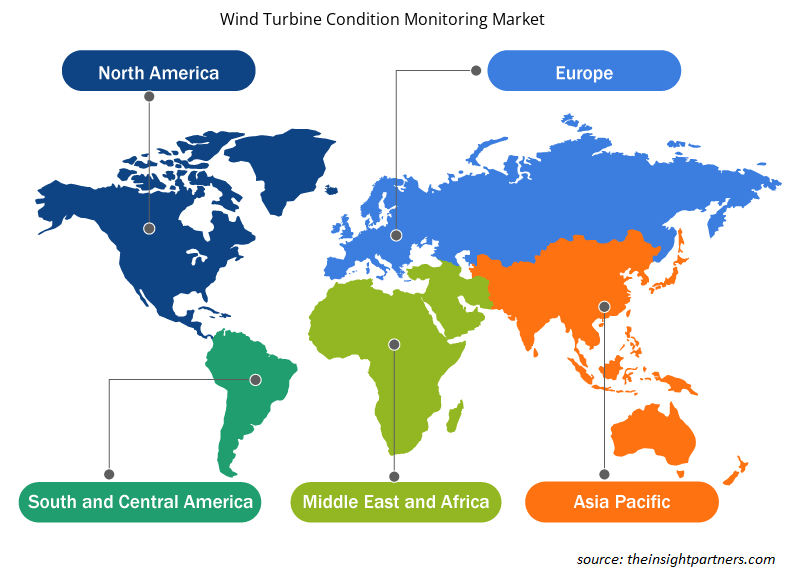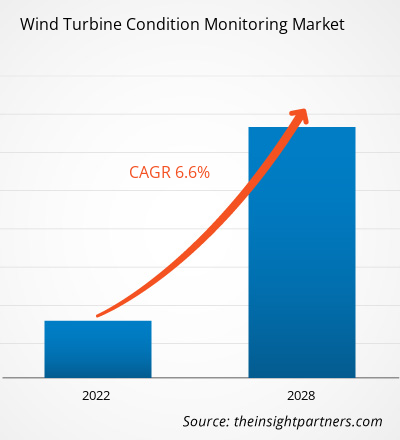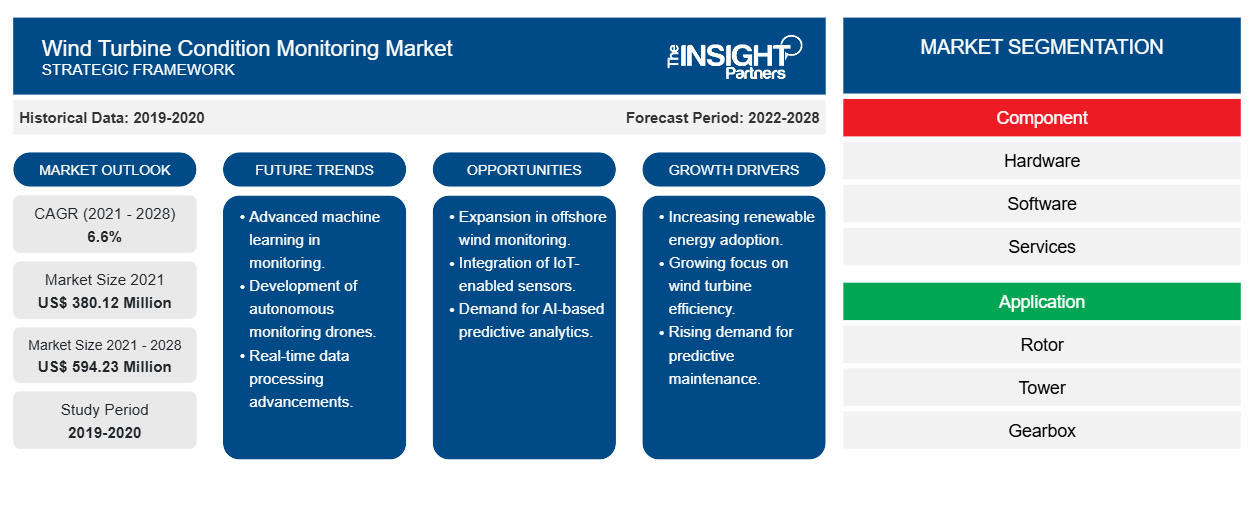风力涡轮机状态监测市场预计将从 2021 年的 3.8012 亿美元增长到 2028 年的 5.9423 亿美元;预计 2021 年至 2028 年期间的复合年增长率为 6.6%。
减少温室气体排放和增加能源结构中可再生能源数量的需要促使了海上风电场的发展。为了减少碳排放、消耗化石燃料、应对气候变化等,能源领域已出现了向可再生和绿色能源的重大转变。这推动了风力涡轮机状态监测市场的增长。
由于技术成本下降、减少二氧化碳排放的需求日益增加以及发展中国家和欠发达国家能源消耗的增加,可再生能源需求将继续攀升。根据国际可再生能源机构 (IRENA) 的数据,到 2050 年,可再生能源在全球年度能源发电中的份额必须从 25% 攀升至 86%,到 2050 年,全球将需要在该领域投资 110 万亿美元,高于 2030 年预计的 95 万亿美元。因此,化石燃料和可再生能源将明显转变。在欧洲,有许多海上风车项目正在运行,占总发电量的 90%。这进一步推动了风力涡轮机状态监测市场的增长
对可再生清洁能源的日益增长的倾向是全球风力涡轮机状态监测市场增长的重要驱动因素。风力涡轮机状态监测市场在发达国家已经成熟,并且在许多发展中国家也大幅增长。由于风电场的高产量和长期扩张,海上风力涡轮机的安装呈上升趋势。此外,全球人口的增长和发展中国家可支配收入的增加也推动了能源消费。然而,海上风电场安装成本高昂阻碍了风力涡轮机状态监测市场的增长。 风力涡轮机状态监测系统有助于精确测量轴弯曲、轴特征或轮廓、轴的扭转振动、轴扭矩、轴转速和轴功率。这些系统被广泛用于故障的早期检测,也有助于最大限度地提高生产力和减少停机时间,从而增加风力涡轮机状态监测市场的增长。
定制此报告以满足您的需求
您可以免费定制任何报告,包括本报告的部分内容、国家级分析、Excel 数据包,以及为初创企业和大学提供优惠和折扣
-
获取此报告的关键市场趋势。这个免费样品将包括数据分析,从市场趋势到估计和预测。
COVID-19 疫情对风力涡轮机状态监测市场的影响
由于政府出台了鼓励创新和增强基础设施能力的优惠政策,北美拥有最高的先进技术采用率。COVID-19 疫情对该地区的可再生能源行业产生了多重影响。由于封锁的影响,风力发电设施的活动减少,包括关闭多个地点的建设、运营和维护项目。在整个风能行业,这些隔离措施和停工导致技术、施工和制造人员休假和裁员,以及许多情况下的项目解散。结果,许多太阳能和风力发电场难以跟上维护和运营。此外,COVID-19 疫情使可再生能源生产商更难获得项目融资或股本资本。因此,COVID-19 疫情对北美风力涡轮机状态监测市场产生了负面影响。
风力涡轮机状态监测市场洞察
风力涡轮机制造和监测的技术进步
更长的叶片和更高的塔架是提高风力涡轮机生产率的两个最关键方面,它们正在推动下一代研究和开发工作,以创造更强大、更高效、更耐用、更具成本效益的涡轮机。其他重大进步包括创建能够收集和理解实时数据的智能涡轮机,以及对风力发电厂流量和涡轮机布局进行建模和调整以优化风能收获。风能技术办公室 (WETO) 与业界合作,提高下一代风能技术的性能和可靠性,同时降低风能成本。此外,美国能源部的风能技术办公室和先进制造办公室正在与公共和私人团体合作,使用增材制造(也称为3D 打印)来生产风力涡轮机叶片模具。传统的叶片设计方法需要开发插头或成品叶片的全尺寸模型,然后利用它制作模具。插头是制造风力涡轮机叶片最耗时和劳动密集的操作之一。因此,3D 打印节省了这些宝贵的资源。风电行业技术必须继续进步,以确保未来的行业增长,在以往成功的基础上提高可靠性、提高容量系数并降低成本。现代风力涡轮机正变得更加经济高效和稳定,其额定功率已提高到多兆瓦级。因此,风力涡轮机状态监测系统的技术进步和现代化将创造大量市场机会。
基于组件的市场洞察
根据组件,风力涡轮机状态监测市场细分为硬件、软件和服务。风速计、位移传感器、数据采集系统和加速度计广泛用于监测风力涡轮机的状态。状态监测工具有助于监测风力涡轮机组件和相关电气系统的健康状况。这些工具通过预测维护问题,帮助风力发电场运营商和所有者在必要时更换组件。例如,KK Wind Solutions 提供多功能数据采集和分析单元,可放置在风力涡轮机的机舱中。这些数据采集和分析单元从各种连接的加速度计和传感器收集数据并传输分析后的信息。基于振动的状态监测系统是用于监测风力涡轮机传动系统的最成熟的系统之一。用于基于振动的状态监测的传感器包括速度传感器、加速度计和位移或距离传感器。
基于应用的市场洞察
根据应用,风力涡轮机状态监测市场分为转子、塔架、变速箱、发电机等。风力涡轮机中变速箱的基本功能是将能量从转子传输到发电机。由于频繁制动和风速变化,负载波动,导致运动部件磨损严重。风力涡轮机变速箱的组件通常用振动传感器监测。由于轴承的共振频率特别高,通常在几千赫兹,因此通常建议使用工作频率在 10 千赫兹及以上的振动传感器来监测高速轴和低速轴。基准风力涡轮机状态监测系统旨在检测和防止变速箱故障。通过准确的实时监测和分析,可以查阅员工时间表,并在早期进行维修,从而有助于节省成本。瑞典是全球脱碳领域的领导者,其目标是到 2045 年实现碳中和,能源部门的目标是到 2040 年实现 100% 可再生电力发电。风能对该国的贡献正在稳步上升,该国的目标是到 2024 年利用 50TWh 的风能。因此,对可再生能源的日益增长的倾向加速了对相应振动传感器的需求。
风力涡轮机状态监测市场的参与者采用合并、收购和市场计划等策略来维持其在市场中的地位。以下列出了一些主要参与者的发展:
- 2022 年,国家海上风电研究与发展联盟 (NOWRDC) 授予了两个 GE 研究项目:一个项目专注于建立大型铸铁件的稳健连接技术,另一个项目专注于使用自主检测船 (AIV) 来检测海上风力涡轮机。
风力涡轮机状态监测市场区域洞察
Insight Partners 的分析师已详细解释了预测期内影响风力涡轮机状态监测市场的区域趋势和因素。本节还讨论了北美、欧洲、亚太地区、中东和非洲以及南美和中美洲的风力涡轮机状态监测市场细分和地理位置。

- 获取风力涡轮机状态监测市场的区域特定数据
风力涡轮机状态监测市场报告范围
| 报告属性 | 细节 |
|---|---|
| 2021 年市场规模 | 3.8012亿美元 |
| 2028 年市场规模 | 5.9423亿美元 |
| 全球复合年增长率(2021 - 2028) | 6.6% |
| 史料 | 2019-2020 |
| 预测期 | 2022-2028 |
| 涵盖的领域 |
按组件
|
| 覆盖地区和国家 |
北美
|
| 市场领导者和主要公司简介 |
|
市场参与者密度:了解其对商业动态的影响
风力涡轮机状态监测市场正在快速增长,这得益于终端用户需求的不断增长,而这些需求又源于消费者偏好的不断变化、技术进步以及对产品优势的认识不断提高等因素。随着需求的增加,企业正在扩大其产品范围,进行创新以满足消费者的需求,并利用新兴趋势,从而进一步推动市场增长。
市场参与者密度是指在特定市场或行业内运营的企业或公司的分布情况。它表明相对于给定市场空间的规模或总市场价值,有多少竞争对手(市场参与者)存在于该市场空间中。
在风力涡轮机状态监测市场运营的主要公司有:
- 研华有限公司
- 远景集团
- 贝克休斯公司
- NERCON 有限公司
- 金风科技
免责声明:上面列出的公司没有按照任何特定顺序排列。

- 了解风力涡轮机状态监测市场的主要参与者概况
全球风力涡轮机状态监测市场根据组件和应用进行细分。根据组件,风力涡轮机状态监测市场分为硬件、软件和服务。根据应用,风力涡轮机状态监测市场分为转子、塔架、变速箱、发电机和其他。
研华科技、贝克休斯公司、ENVISION 集团、ENERCON GmbH、goldwind.com、通用电气、NORDEX SE、西门子歌美飒可再生能源、德国莱茵 TÜV 和维斯塔斯是本次研究考虑的几家风力涡轮机状态监测市场主要参与者。此外,本研究报告还研究和分析了其他几家重要的风力涡轮机状态监测市场重要参与者,以全面了解全球风力涡轮机状态监测市场及其生态系统。
- 历史分析(2 年)、基准年、预测(7 年)及复合年增长率
- PEST和SWOT分析
- 市场规模、价值/数量 - 全球、区域、国家
- 行业和竞争格局
- Excel 数据集
近期报告
相关报告
客户评价
购买理由
- 明智的决策
- 了解市场动态
- 竞争分析
- 客户洞察
- 市场预测
- 风险规避
- 战略规划
- 投资论证
- 识别新兴市场
- 优化营销策略
- 提升运营效率
- 顺应监管趋势























 获取免费样品 - 风力涡轮机状态监测市场
获取免费样品 - 风力涡轮机状态监测市场